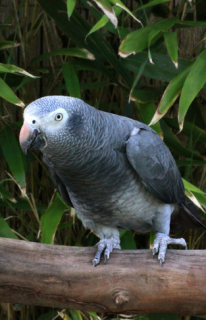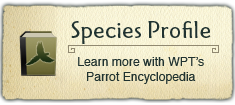Project Regions:
Timneh Parrot |
|
|
Collaborators/Funders
IBAP (National Institute for Biodiversity and Protected Areas), the Coastal Planning Cabinet of Guinea-Bissau, Dr. Paulo Catry (ISPA – Instituto Universitário, Portugal), Dr. Davide De Guz, The Wara Conservation Project (SALF and GALF programmes), Save Our Species (SOS), ZooMarine Portugal, Whitley Wildlife Conservation Trust, Bridging Peace Foundation, Folke H Peterson Trust, MAVA, Explore Trees
Heavy trapping and habitat loss are fueling Timneh Parrot population collapses
Heavy trapping for the wild bird trade (199,070 individuals exported from 2005-2014) and habitat loss (up to 77%) have caused Timneh Parrot populations to severely decline. The largest groups are thought to be in Côte d’Ivoire and Liberia, although it has vanished on Mt Nimba and the East Nimba Nature Reserve in Liberia. Local people are reporting seeing them less.
How WPT makes an impact: In 2013 WPT supported Guinea officials in the rehabilitation and release of thirteen confiscated Timnehs. WPT has since worked with regional partners to document the species' ecology, population and care for confiscated birds. In late 2016, WPT presented at the Conference of the Parties for CITES 17, where delegates voted to uplist Timneh Parrots to Appendix I, thus banning commercial trade. Later, researchers found that populations on Bijagós and Pecixe islands in Guinea-Bissau had declined. In addition, counts in Sierra Leone found very low numbers despite the discovery of a significant population. On the Bijagós, UNESCO Biosphere reserve community-based initiatives have employed former poachers to guard nests. In Liberia, WPT is helping Libassa Wildlife Sanctuary build more capacity and giving veterinary and care training.
Population: 100,000-500,000, decreasing.
Vital statistics: Size: 30 cm (11.7 in) Weight: 320 g (11.2 oz)
Range: Native to the western parts of the moist Upper Guinea forests and bordering savannas of West Africa extending from the Bijagós islands of Guinea-Bissau eastwards through southern Guinea, Sierra Leone, Liberia and Côte d’Ivoire.
Natural history: Is found in primary and secondary rainforest, forest edges and clearings, gallery forest, mangroves and savanna. Diet consists of a variety of seeds, nuts, fruits (including oil palm) and berries. Will sometimes travel great distances for food. Are generally seen in small, but vocal, flocks of a few dozen. Breeding is during the dry season; January-February, and June-July. Nest is in a high, live tree in a hollow.
Project Updates
Article: Trade in Grey Parrots and Timneh Parrots is currently not sustainable
- PsittaScene Vol. 30.1, Spring 2018
- PsittaScene Vol. 28.2, Summer 2016
- PsittaScene Vol. 28.2, Summer 2016
- PsittaScene Vol. 27.4, Winter 2015
- PsittaScene Vol. 26.3, Autumn 2014
- PsittaScene Vol. 25.4, Winter 2013


































